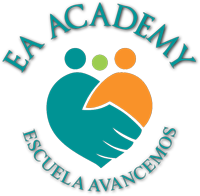Curriculum , Instruction & Assessment
The curriculum is anchored in the common core state standards, which define what students should know and be able to do at each particular grade level. Content instruction includes English language arts, mathematics, science, social studies, physical education, technology, and arts.
English Language Arts
The Academy is committed to utilizing curriculum and pedagogy that is research-based and has demonstrable success in independent studies. The U.S. Department of Education, through its subsidiary, Institute of Educational Sciences (“IES”), maintains a database of educational programs that have documented positive effects on students' learning. The What Works Clearinghouse (“WWC”) looks at the expected changes in student percentile ranks with the utilization of any given academic program.
The core elements of the instructional model, as adopted and implemented at the Academy and articulated in the study, are as follows:
Cross-grade ability grouping and regrouping: Students are placed in a reading class that is aligned to standardized testing scores; a placed student may be grouped with younger or older students. Students are regrouped following administration of standardized testing during the winter.
90-minute reading block: All ELA lessons are scripted for 30 minutes and mirror the Cycle of Effective Instruction, which contains the following 4 stages of instructional delivery: direct instruction; teamwork; assessment; and celebration. An emphasis on teamwork is evidenced by the majority of instructional time spent within this subcomponent within the scripted lessons.
Scripted and timed lessons: All lessons are accompanied by a script and are timed in order to address all requisite reading skills.
Technology-supported instruction: All lessons are supported with multimedia presentations and SmartBoards
Data-driven instruction: Instructors are expected to gather data throughout the lesson cycle in the form of formative assessment and summative assessment. Comprehensive and detailed performance scales accompany all performance tasks within each lesson and students are provided copies of each rubric.
Cooperative learning: A majority of the learning process occurs in the contexts of student partnerships and teams.
The Academy delivers daily differentiated instruction for nonfiction reading and writing that are tailored to each student’s Lexile® reading level.
Success for All: Success For All Foundation - Success for All Foundation
Mathematics
With respect to mathematics, the Academy has implemented a research-based, effective math curriculum, Great Minds™ Eureka Math2®. The curriculum is fully aligned with the MAS for all grades.
- Great Minds - Eureka Math Squared (EM2) - Eureka Math²® - Elementary and Middle School Math Curriculum
Science
Science instruction is led through highly crafted learning expeditions that are inquiry-based and have a strong basis in lab work, exploration and mastery of specific concepts. Amplify Science is grounded from the work outlined by the Next Generation Science Standards (“NGSS”) from the National Research Council. Place-based education helps students explore the local environment. Science instruction provides virtual labs for all students that supplement more traditional labs in the core disciplines of science.
- Amplify Science: K-8 Science | Elementary & Middle School Curriculum | Amplify
Social Studies
Academy students work toward state standards through use of a wide array of monographs, textbooks, stories, videos, web sites, maps, pictures and other historical sources to study cultures, geography and social sciences. Using the Michigan Association of Intermediate School Administrators (“MAISA”) MC3 social studies curriculum, students explore the five social studies disciplines of history, geography, civics and government, economics, and of public discourse, decision-making and citizen involvement. Middle School students will have access to the TCI (Teacher’s Curriculum Institute) Social Studies curriculum, an interactive program integrating engaging discourse with innovative technology, allowing students to construct arguments using primary sources and multimedia features, which support inquiry-based learning.
1. TCI (Social Studies - Middle School), Studies Weekly (Social Studies - K-5):
Middle School Social Studies Curriculum | TCI Interactive Learning
Art
Arts instruction is infused throughout the curriculum and learning expeditions increase student engagement in school and thus increase academic achievement. Artistic expression and creativity are essential components of a complete education. Teachers provide students with a range of creative and cultural opportunities, including fine and creative arts classes. At the end of every arts module, culminating celebrations of learning allow students to perform, demonstrate and exhibit their accomplishments, bringing students, families and the community together. Through arts infusion, passion is sparked that will propel students to realize their potential and become creative, perceptive, lifelong learners.
Spanish
As a community and neighborhood school in southwest Detroit, the Academy’s targeted student body is Latino/Latina students. In response to this, and in commitment to the academy’s core value of bi-literacy, all students take Spanish. The Español Santillana and Academy written curriculum used for Spanish language instruction are aligned to MAS through the work6 done by the American Council on the Teaching of Foreign Language (“ACTFL”). The MAS establish a clear set of expectations for ELA and mathematics, along with a set of standards for content area literacy. World language standards set expectations in five areas – Communication (interpersonal, interpretive and presentational), Cultures, Connections, Comparisons, and Communities – as well as three proficiency levels – Novice, Intermediate, and Advanced (ACTFL, 2012).
Physical Education and Health
The Exemplary Physical Education Curriculum™ (“EPEC™”) utilizes standards-based instruction and is designed to improve motor skills, healthy active living, fitness ability, sportsmanship and increase student’s physical literacy. Simultaneously, students receive instruction in a health education curriculum that is aligned with the recommended grade-level Michigan health education content standards that include: core concepts, access information, health behaviors, influences, goal setting, decision making and social skills.
1. Michigan Model For Health: HOME | Michigan Model for Health™
2. Exemplary Physical Education Curriculum (EPEC): EPEC - MFF
The following assessments are used to identify student proficiency and progress:
M-STEP (grades 3-6): https://www.michigan.gov/mde/0,4615,7-140-22709_70117---,00.html
NWEA MAP/MPG (grades K-6): https://www.nwea.org/map-growth/
Annual Education Report
Annual Education Report (AER) 2023-2024
Annual Education Report (AER) 2022-2023
Annual Education Report (AER) 2021-2022
Annual Education Report (AER) 2020-2021
Annual Education Report (AER) 2019-2020
Annual Education Report (AER) 2018-2019
Annual Education Report (AER) 2017-2018
Annual Education Report (AER) 2016-2017
Annual Education Report (AER) 2015-2016

